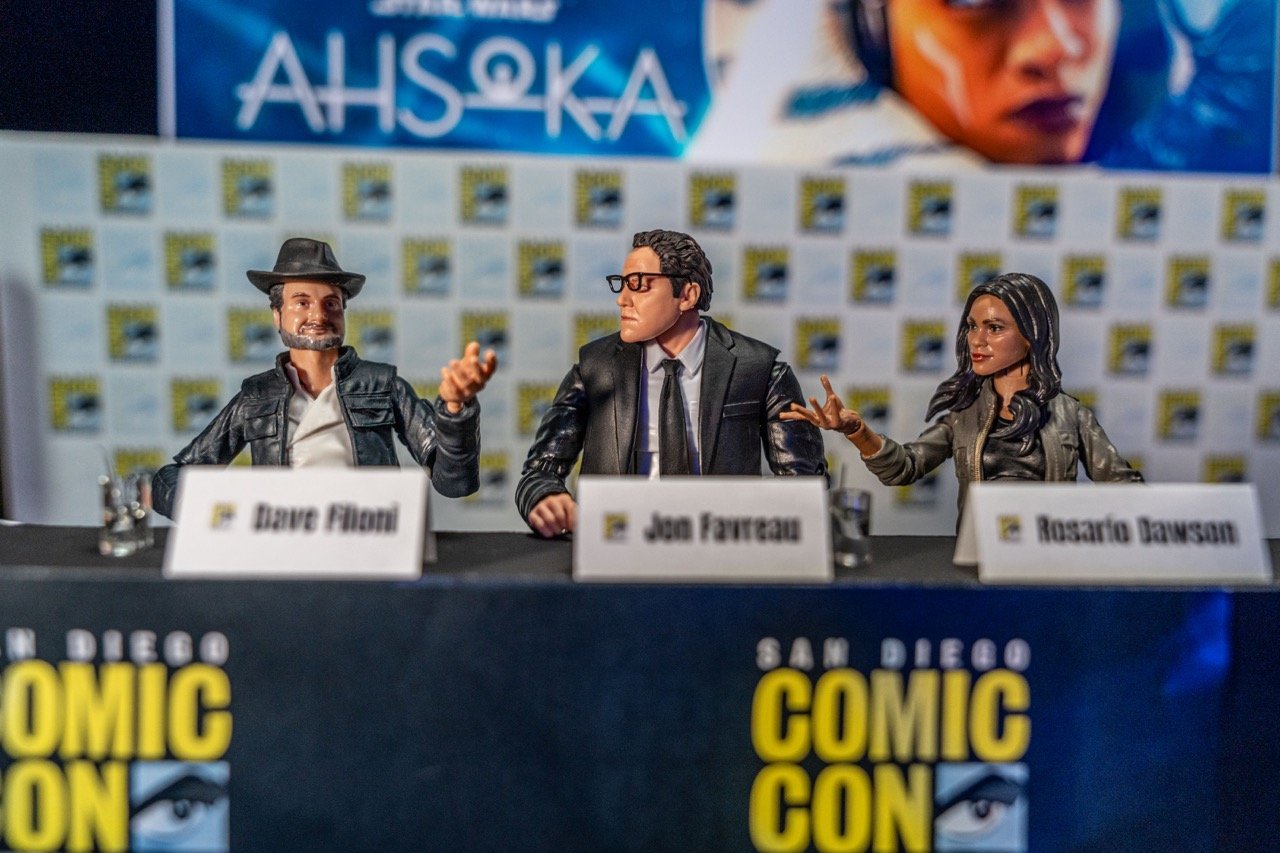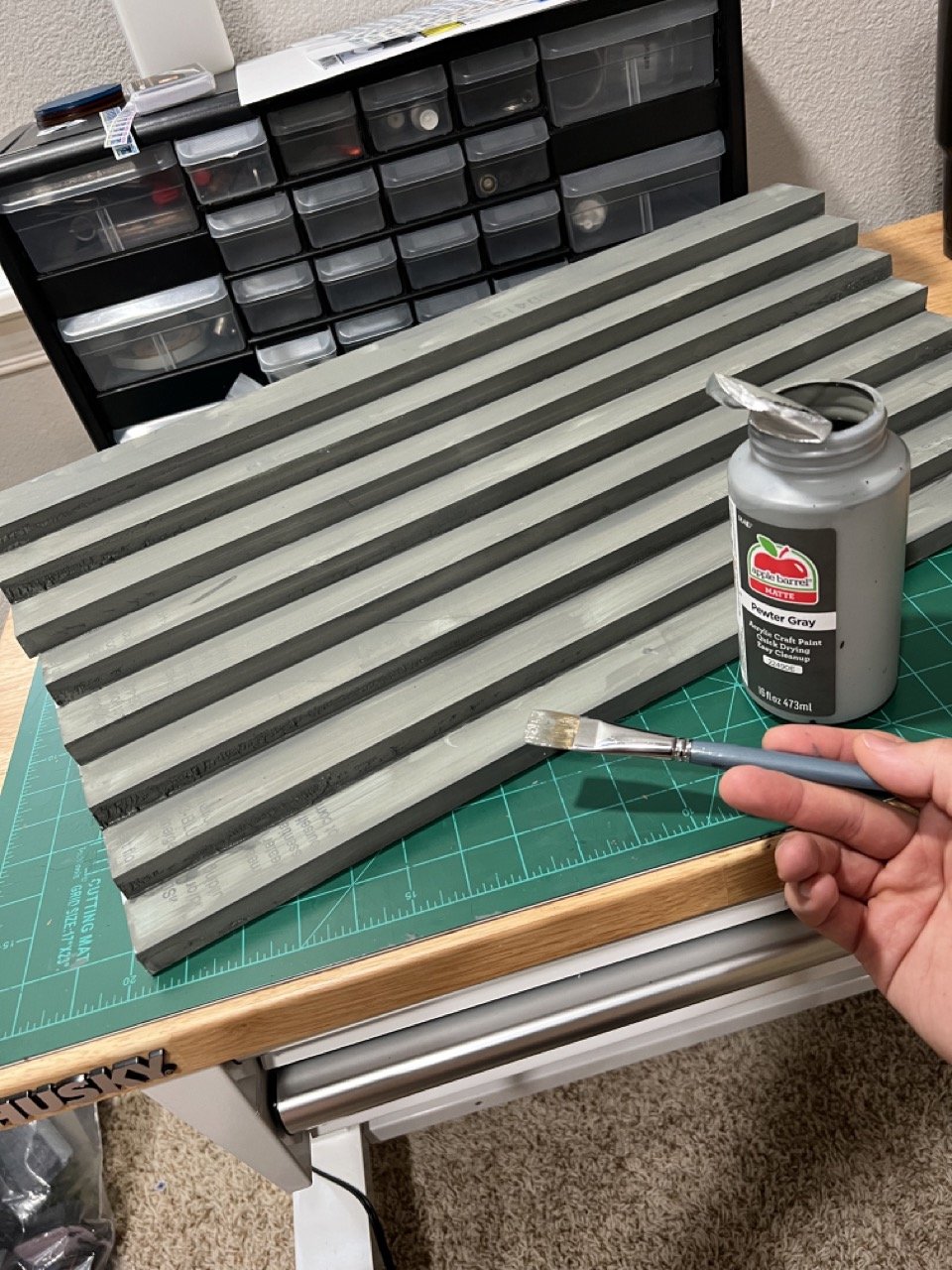Digirama
As part of my series that explores visual effects techniques this method is one of my favorites. As the originator of the Digirama technique, seeing it used specifically in the toy photography community has been a joy! Of the countless techniques that can be used for photography and video, Digirama is one of the most powerful and efficient tools. When I introduced Digirama through my early photography work, I was excited about the its potential and the endless possibilities it could provide for other artists. Since this method uses a digital backdrop to create diorama, I coined the phrase "Digirama"!
Though I usually only create one photo with these technique exercises, I thought it would be fun to change it up. Since I was unable to attend San Diego Comic Con in 2023, I decided to redirect my FOMO (fear of missing out) and create a toy photography series instead. Each of the 4 days of the Con, I created a unique shot that tried to capture the essence of the SDCC experience.
Before we go any further…
Years ago I put together a highly in-depth 3-part series on Digirama. Click the links below to visit the tutorials!
HISTORY OF THE TECHNIQUE
REAR PROJECTION
Before the modern methods of implementing digital backgrounds in film and television production, the analog approach was to project filmed sequences on a white screen that was placed behind the subject. Known as Rear Projection, it quickly became the go-to standard technique and was used in countless television and film productions for decades.
Rear projection has been a staple of filmmaking since its early days, contributing to the visual aesthetics of classic films.
Alfred Hitchcock understood how to leverage this technique to enhance his storytelling, create memorable sequences, and maintain artistic control over his films. The use of this technique in North By Northwest allowed Hitchcock to shoot this thrilling sequence in a controlled environment, ensuring the safety of the actors and crew while still achieving a dynamic and visually striking scene.
Though modern filmmaking now relies heavily on CGI for similar effects, the use of rear projection remains an important part of the history of cinema.
The future of production
The Volume, a cutting-edge virtual production stage developed by Industrial Light & Magic (ILM) played a revolutionary role in the production of "The Mandalorian" TV series. It is essentially a massive LED video wall that surrounds the physical set, displaying high-resolution, real-time digital backgrounds and environments. This technology eliminated the need for traditional green screens and post-production CGI work making the creative process more efficient and dynamic.
It also facilitated a greater sense of immersion for the actors, who could react naturally to the virtual surroundings, leading to more authentic performances. Moreover, the real-time nature of the Volume allowed the production team to make immediate adjustments to lighting, camera angles, and backgrounds, streamlining the filmmaking process. The success of "The Mandalorian" and the widespread recognition of the Volume's impact have ushered in a new era of virtual production in the entertainment industry, setting a precedent for future TV shows and films to explore the possibilities of this game-changing technology.
WHY I named IT “DIGIRAMA”
When I started learning photography in 2015, I had already gained over 10 years of experience within the world of production. Not only did I work on set at times as an art director (and sometimes as talent), I also spent a significant amount of time in post-production setting. I was fortunate to see both sides of the process and understand the workflow.
I defaulted to what I knew best when it came to creating my photos - compositing and digital manipulation. With over 2 decades of experience in the world of production and post-production, I was able to leverage my knowledge and skills as I began photography as a hobby. I was particularly interested in understanding low-light photography and as fate would have it, my first shots included an action figure as my subject.
The figure was Darth Maul from the Star Wars The Black Series line of 6” action figures by Hasbro. At the time I did not have any dioramas or printed backgrounds that I could implement into the setup. Thanks to my background and love for efficiency, I did what only made sense - I grabbed my laptop and found a screenshot from one of the Star Wars movies. My initial test shots weren’t bad but the process and use of a digital image as a background truly had my mind racing.
As I continued to develop this style for my own toy photography, I decided to give it the name “Digirama" as it best described the ability to use a digital image to create a diorama!
PROOF OF CONCEPT
WHERE IT ALL BEGINS
If you have been following along with this Techniques series or are familiar with my process, you know I occasionally will work out concepts prior to even grabbing my camera or action figure. A lot of times I will sketch out ideas using just a pen and post-it note, but for this series I used Procreate on my iPad to sketch them digitally. Going through this process is an efficient way to brainstorm ideas and discover the best concepts worth pursuing. In addition, the ability to refine layout and composition can be a huge time-saver.
Digirama IN ACTION
Shot 1 - SAN DIEGO COMIC CON CROWD
For those who have ever had the opportunity to attend San Diego Comic Con, I'm sure you'd agree its equally incredible and overwhelming. The average attendance exceeds 135,000 people each year! Just outside the San Diego Convention Center the sidewalks and street are flooded with people creating a terribly claustrophobic experience.
To capture that feeling, I grabbed a handful of mixture of action figures that could work great as everyday civilians or could be kitbashed to make unique people in costume. You'll notice I had a bit of fun when it came to posing the figures - did you find Waldo? For the digirama portion of this shot, I found a picture that I took the last time I was at SDCC in 2019. After some minor editing in Adobe Photoshop, the next step was to display it on the television screen behind the figures.
Though there are numerous ways you could do this, my preferred method is to open the image in Photoshop on my laptop and mirror it to the television screen. Keeping the image in Photoshop allows me to make any quick adjustments and also move the image around the canvas to crop and resize the image if necessary. As you can see in the diagram, I am only using a portion of the entire photo, cropping out a majority of the foreground. To nail the illusion, the camera perspective of the original photo (used for the digirama) needs to match the physical camera for this setup. Using the horizon as reference I optically aligned the tops of people's heads in the photo with the tops of my action figures to blur the lines of digital and physical.
Matching the light is a ket component for selling the illusion. Creating outdoor shot like this one ends up being pretty straight-forward since the primary light source is the sun. Taking note of how the shadows in the original photo were being cast, I could approximate the location of the sun and place my LED light panels in a similar position to create complimentary shadows.



Shot 2 - STAR WARS HALL H PANEL
During the handful of times I've attended SDCC, I have never experienced the excitement and utter chaos of a panel in Hall H... and I'm okay with that. The largest and most iconic halls in the San Diego Convention Center, Hall H hosts some of the most anticipated and high-profile panels, presentations, and screenings during the convention. My goal with this shot was to imagine what a Star Wars panel featuring the Disney+ streaming series Ahsoka could look like. I had a tremendous amount of fun using various action figures from the Marvel Legends and Star Wars The Black Series lines to fill the scene. Creating the printed props including the table cloth, name cards, and SDCC logo background add an extra level of detail that I think elevates the concept.
For the digirama part of this photo, I chose to create my own background by taking an alternate close-up photo of the Rosario Dawson action figure. Once displayed on the TV screen behind the diorama, this alternate photo really sells the look of a live video feed behind the stage.





SHOT 3 - COSPLAY PHOTO OP
One of the years that I attended SDCC, my brother and I decided it would be fun to cosplay. Being huge fans of both Star Wars and Daft Punk, we decided to combine the two into our costumes and called it "Fett Lucky".
It was an incredible experience and for this shot, I decided to commemorate it in toy photo form. Again, I took parts from Star Wars the Black Series as well as Marvel Legends figures to create toy versions of both my brother and me in costume. Shooting at ground level means you can mix the scale of objects in the scene and create a fake sense of depth through forced perspective. In the behind the scenes photos, you can see how this trick works within a relatively small amount of space.








Shot 4 - COSPLAYERS UNITE
My favorite part of the convention experience is reconnecting with friends, both old and new. For the final shot in this SDCC-inspired toy photo series, that community aspect was what I was hoping to capture. By the end of the con, you can find many clubs and groups taking group photos. One of the popular spots for these meetups is on the Mezzanine stairs outside of the convention center.
Creating this shot was so much fun! To represent the numerous fandoms, I was able to pick from my entire action figure collection and include my favorites in one single shot - something I don’t do often. Using this efficient technique along with a simple setup, I was able to focus on the characters to tell their stories. This shot was the perfect way to sell the idea of community and camaraderie.








THE FINAL RESULTS
THE POWER OF DIGIRAMA
Digirama has become an extremely powerful and efficient tool for photography. Over the course of nearly a decade, I've continued to push the technique in my own work. Fast forward to today and I am thrilled to see the technique being implemented by so many photographers and videographers.
If you have tried this technique in any of your work, tag me in your posts on instagram use the hashtag #wmoldigirama in your caption. I would love to see your take on using digital backgrounds in your shots! Since this is an ongoing series, what other techniques should I explore?
Thanks for learning with me and hopefully this inspires you to get creative with your next project.




THE PRINT
As part of my series that explores visual effects techniques, my exercise in Digirama resulted in 4 unique SDCC inspired photos. The photo "SDCC Day 1" was by far the most popular of the series and is offered as a timed edition print.
“SDCC Day 1” is an archival-grade print on Fuji Crystal luster photo paper and mounted on black styrene board for long-lasting durability. Please allow up to 2 weeks before your order arrives.
Currently available for US and Canada orders only. Please email info@invisibleelement.com if you would like a custom quote for shipping or have additional inquiries.






























